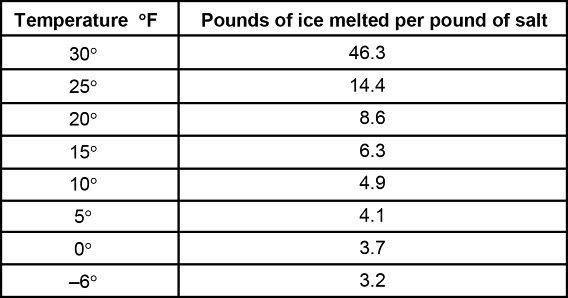









© 2023 Ice & Snow Technologies, Inc. Phone: (509) 525-3197





Snow and Ice Control Operations Specialist
Highway and Roadways Maintenance Expert
Leading Snow Industry Consultant and Trainer
Rock Salt vs. Brines
by Dale Keep, Road Deicing Consultant and Trainer

In recent years, the use of chloride brines such as salt, calcium, and magnesium chloride as opposed to, or as a
supplement to dry salt has increased. With the question of availability and price of rock salt always lingering,
now is a good time to look at them and how they compare.
Melting Ice With a Solid
All solid deicers melt ice by first forming a brine solution by using available water in ice and/or snow to form it.
Rock salt, for example when applied to an icy surface will absorb available water to form a solution. If there is
enough salt available compared to the water quantity and other conditions such as temperature are correct, the
solution formed will naturally be around 23%, which is the concentration manufactured salt brine is made to.
Solution stability
The ability of a chemical to stay in solution (stability) depends on the solution temperature. Lowering the
temperature of a super saturated brine will typically cause the chemical to form crystals and/or precipitate out
solids. This “shedding” process affects the concentration of the solution, plugs equipment and simply is not a
good thing. For example, if a solution of salt brine were made at a solution higher than 23.3% with warm water,
when the brine cools, the excess salt would precipitate out in the form of solids. This can cause all kinds of
equipment and other problems. The maximum stable concentration for salt brine (eutectic concentration) is
23.3%. Other products have similar characteristics, but the specific details are different.
Specific gravity
Specific gravity is used in many ways, but in the deicer products it indicates the concentration and weight per
gallon of the brine. It is expressed as a multiple of the weight of the same volume of pure water under prescribed
conditions. For example, the specific gravity of 23% salt brine is 1.175. This means that a gallon of salt brine
weighs 1.175 times more than a gallon of pure water. Given that a gallon of cold-water weighs 8.34 pounds, a
gallon of 23% salt brine weighs (8.34 x 1.175) 9.8 pounds. As 23% of that weight is salt, a gallon of 23% salt brine
contains (9.8 x 0.23) 2.25 pounds of pure salt as an active ingredient. This 2.25 pounds is called the “Dry
Equivalent”. It is important for winter maintenance personnel to know the specific gravity, concentration, freeze
point and other details about the brine they are using.
Dry Equivalents
A gallon of 23% salt brine contains 2.25 lbs of salt. Imagine an application of 75 gallons per acre. This liquid
application represents 168.75 pounds (2.25 x 75) of pure salt needed in the dry form for the same melting capacity.
Melting Capacity
The brine, product used, application rate and the pavement surface temperature will determine how much ice is
melted. Temperature affects the melting capacity of all products. The colder it is, the smaller the melting
capacity of the deicer product in use.
As temperatures fall, deicer products are less effective. Simply put it takes more chemicals to remove the ice
present, or to keep the water wet. Because of this, there are practical cold temperature limits for the use of any
deicer product. This limit is typically called the “Effective Temperature”. At cold temperatures, results from
applications can be slow in coming and very chemical intensive. In extreme cold the addition of a good
performing cold weather deicer brine to rock salt will enhance the salts cold weather performance. This is
particularly true if a high performance at cold temperatures liquid such as calcium chloride is used. Conversely,
in the upper below freezing temperatures, a small amount of only salt can get the job done. This fact is clearly
represented in the following table. The table below shows how temperature affects the ability of salt to melt ice.
Retention
Retention of dry deicer products when applied can be a problem due to bounce and scatter and traffic action in
general. This is particularly true when applied to dry pavements. Dry deicer products are susceptible to
displacement by wind and traffic action. Chemical loss can be minimized by using a direct brine application,
and/or by pre-wetting rock salt with a brine. Brines in most cases can be applied as needed, and retained where it
is applied when properly done. However, both liquids and solids have their place in the snow fighter’s toolbox.
Equipment
Using brine has some associated costs issues regarding storage, spreading equipment, and sometimes brine
manufacturing equipment. While the start up costs for equipment is there, most find the use of brines to be
beneficial once they learn when to use them, and how to do so correctly.
Summary
It is this writer’s opinion that both rock salt and brines are important tools in winter maintenance. The manager’s
task is to determine which should be used when or in combination with each other. Often many variables
including current weather, expected weather, contract terms, and availability of labor, equipment and materials
must be considered in the decision-making process.